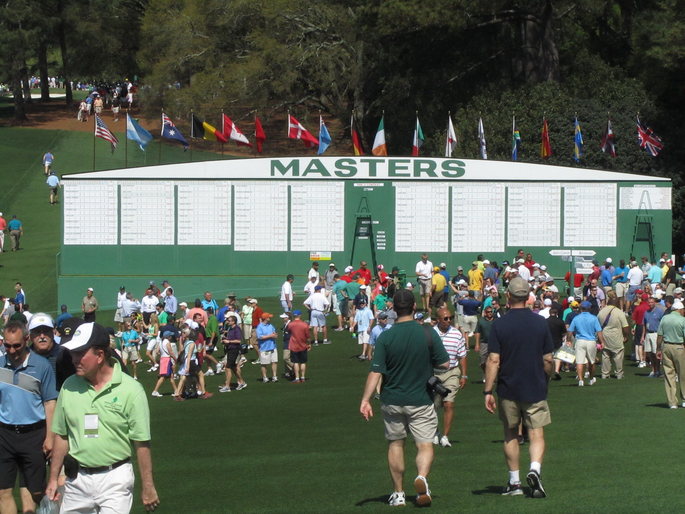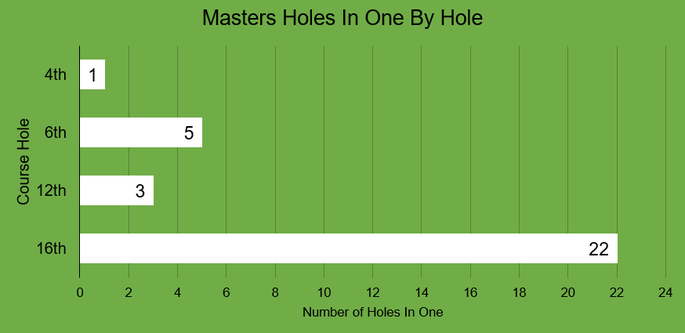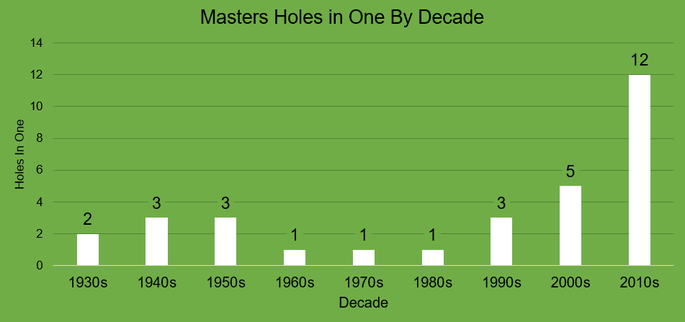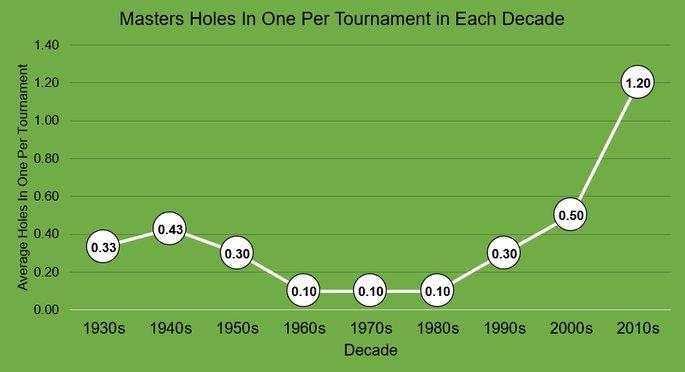 Golf has always been a sport that has tormented its players. Why is it that you can hit a perfect shot one minute and then feel as though you’re trying to dig your way off the course the next? Whilst most golfers just dream of a bit of consistency, those at the top level of the game like to dream of hitting a hole-in-one whenever they step up to the tee at a par three. If you can hit the ball far enough to reach the green, why not just get it in the cup?
Golf has always been a sport that has tormented its players. Why is it that you can hit a perfect shot one minute and then feel as though you’re trying to dig your way off the course the next? Whilst most golfers just dream of a bit of consistency, those at the top level of the game like to dream of hitting a hole-in-one whenever they step up to the tee at a par three. If you can hit the ball far enough to reach the green, why not just get it in the cup?
That’s very much the thinking of the men who step up to the plate in the US Masters, hoping to take the Augusta National course by the scruff of the neck. When they achieve it they not only manage to keep their score down but they also earn the adoration of the golf-loving public. On top if that, they get a little gift from golf’s organising body as recognition of their achievement. The question is, just how often does it happen?
How Often is There a Hole In One at the Masters?
There have been 31 holes-in-one at the Masters. With 83 tournaments played up to 2019, this averages out as just under one every 3 years over the history of the competition. Twelve of these have been since the year 2010 however, meaning there was an average of 1.2 holes-in-one scored in each tournament that decade.
Players Who Have Achieved A Masters Hole-In-One

By Dan Perry, flickr
Let’s have a look at the players that have managed to wow the crowds by hitting the cup with just one shot over the years. Sufficed to say that the list isn’t the longest, not least of all because it is an incredibly hard feat to achieve. When you consider that the golfers that line up to play at the Masters are the cream of the crop and even they struggle to do it, you can understand why.
At the time of writing there have been thirty-one golfers to net a hole-in-one, though no golfer has done so more than one at the Augusta course. In 2020, Jon Rahm, one of the favourites for that year’s contest, made the headlines by getting two aces during his practice round, including one that quite literally skipped across the water and traversed the green to make it to the hole. Sadly the fact that they were done in practice rounds meant that they didn’t count.
It’s hardly shocking to report that all of the holes-in-one at Augusta National have come on the par three holes, with the sixteenth being the one that has boasted more than any other. Here’s a look at the players that have pulled it off, listed by the holes that they did it on:
Masters Holes In One – 1934 to 2019
| Hole | Player | Year | Distance | Club |
|---|---|---|---|---|
| 16th | Bryson DeChambeau | 2019 | 179 yards | 7 iron |
| 16th | Justin Thomas | 2019 | 179 yards | 8 iron |
| 16th | Charley Hoffman | 2018 | 173 yards | 6 iron |
| 16th | Matt Kuchar | 2017 | 170 yards | 7 iron |
| 16th | Shane Lowry | 2016 | 181 yards | 8 iron |
| 16th | Davis Love III | 2016 | 181 yards | 7 iron |
| 16th | Louis Oosthuizen | 2016 | 181 yards | 7 iron |
| 6th | Jamie Donaldson | 2013 | 177 yards | 7 iron |
| 16th | Bo van Pelt | 2012 | 202 yards | 6 iron |
| 16th | Adam Scott | 2012 | 202 yards | 7 iron |
| 16th | Nathan Green | 2010 | 176 yards | 6 iron |
| 16th | Ryan Moore | 2010 | 176 yards | 7 iron |
| 16th | Ian Poulter | 2008 | 169 yards | 8 iron |
| 16th | Trevor Immelman | 2005 | 177 yards | 7 iron |
| 16th | Kirk Triplett | 2004 | 177 yards | 6 iron |
| 16th | Padraig Harrington | 2004 | 177 yards | 6 iron |
| 6th | Chris DiMarco | 2004 | 198 yards | 5 iron |
| 16th | Raymond Floyd | 1996 | 182 yards | 5 iron |
| 16th | Corey Pavin | 1992 | 140 yards | 8 iron |
| 4th | Jeff Sluman | 1992 | 213 yards | 4 iron |
| 12th | Curtis Strange | 1988 | 155 yards | 7 iron |
| 6th | Charles Coody | 1972 | 190 yards | 5 iron |
| 16th | Clive Clarke | 1968 | 190 yards | 2 iron |
| 12th | William Hyndman | 1959 | 155 yards | 6 iron |
| 6th | Leland Gibson | 1954 | 190 yards | 4 iron |
| 6th | Billy Joe Patton | 1954 | 190 yards | 5 iron |
| 16th | John Dawson | 1949 | 190 yards | 4 iron |
| 12th | Claude Harmon | 1947 | 155 yards | 7 iron |
| 16th | Ray Billows | 1940 | 145 yards | 8 iron |
| 16th | Willie Goggin | 1935 | 145 yards | Spade mashie |
| 16th | Ross Somerville | 1934 | 145 yards | Mashie niblick |
As you can see, the sixteenth is far and away the most popular hole for nailing a hole-in-one, but is there a reason for that? Why is it that the other par three holes only have a handful of aces attached to them but there have been twenty-two on the sixteenth at the time of writing? The answer, of course, lies in the geography of the course. Whilst the others holes give the designers options, the sixteenth really doesn’t.

Standing between the sixteenth tee and the green is a large water hazard on the left, with trees and bunkers to the right. There is only a limited amount of real estate for the course designers to work with, so the only real thing that they can play with is the position of the pin. The bunkers around the green mean that you absolutely need to hit it if you want to avoid a heavy score, so if you’re landing it on the green then why not aim for the cup?
The other par threes on the course have a little bit more flexibility to them, allowing the course designers to make life trickier for the players. It’s worth remembering that a hole-in-one is not a good thing for the designers, suggesting that they’ve made the holes to easy for the players and often resulting in a re-think. If they can make the pin position tricky and ask questions of the golfers then they will, naturally making a hole-in-one more unlikely.
How Common Are Holes In One at the Masters?
Most bookmakers allow punters to have a bet on any player getting a hole-in-one at some point during the tournament, without the need to specify which player or on which hole. It’s something of an open-ended bet, meaning that as long as one of the golfers taking part in the competition achieves it then your wager will be a winner. The question is, though, how likely is it to actually happen during any given Masters?
As we have mentioned earlier, 12/31 holes-in-one were scored between 2010 and 2019, with only one scored in each of the 1960’s, 1970’s and 1980s.

You can see from the chart that there was an increase in the number scored each decade since the 80s, rocketing when we get to the 2010s. We can also look at the number of holes-in-one scored each tournament by decade, which is shown below.

This chart shows us that for most of the tournament’s history, holes-in-one were extremely rare, though this increased to 1 in every 2 tournaments between 2000 and 2009, increasing to more that one per tournament between 2010 and 2019.
When looking at the betting for a hole in one at the Masters, the odds are around 1/2 for any to be scored during a tournament, with individual players priced at around 50/1 to do so.
What are the Chances of a Player Hitting a Hole In One?

Simply playing the numbers suggests on any give hole by any given player that it’s not that common to hit a hole-in-one. At the time of writing there have been thirty-one holes-in-one during the history of the US Masters. Given that the event first started in 1934 and that between ninety and one hundred golfers are invited to take part every year, that’s an awful lot of golf that has been played over the years with a relatively tiny amount of holes-in-one to accompany it.
The Masters has taken place eighty-two times to date, with only the three years during the Second World War seeing play not taking place. The tournament consists of four rounds of eighteen holes, with a Cut taking place after the first thirty-six holes. This hasn’t always been the case, however, making it virtually impossible to calculate how many holes of golf have actually been played during the Masters Tournament over the years.
If you work on the basis that one hundred golfers will play thirty-six holes and fifty will play an additional thirty-six then in one year alone there will be around nine thousand holes played each year. Working on that basis, there have been approximately 738,000 holes of golf played since the tournament began. That is obviously only a rough calculation, but it should give you some sense of just how much half has been played at Augusta as part of the Masters.
To put it another way, somewhere in the region of 0.0042% of holes played have ended in a player scoring a hole-in-one. With that in mind, it’s probably worth limiting the stake size of any bets placed on a hole-in-one occurring during a tournament. One thing you might want to do is keep an eye on the practice rounds, given that holes-in-one scored then might indicate that it’s possible for players to get one during the tournament proper.
Something else to bear in mind is the fact that twenty of the thirty-one aces have been achieved since 1990. The suggestion, then, is that it’s become easier to get a hole-in-one at Augusta National Golf Course, either because players are able to hit the ball further, have more control over it thanks to developments in golf club design or the course has just become a bit easier. If you only look at those scored after the turn of the millennium the figures shift again.
Let’s say that we’re only considering holes-in-one from after 2000 and we’re assuming that one hundred players played the course and fifty made the Cut. In that instance, it would mean that about 0.0099% of holes end in a hole in one. Still a small amount, but larger than if you’re looking at the entire history of the Masters. Regardless of the numbers, whether you want to bet on a hole-in-one will probably come down to whether you’re feeling as lucky as the golfers hoping to hit one.
What Do You Get For A Hole-In-One At The Masters?

We know that the winning golfer of the entire event gets given not only the Masters Trophy, which depicts the clubhouse, but also the famous green jacket. The trophy has been in existence since 1961, with a Sterling silver replica given to the golfer to take home since 1993, alongside a gold medal.
That’s for the golfer that comes out on top and beats all-comers to the trophy, but what about those that manage to achieve the impossible dream and sink a hole-in-one? They get a nice little award of their own, which comes in the form of a large crystal bowl. Something similar was given to Bruce Devlin in 1967 when he managed to get a Double Eagle on the eight hole, which is indicative of the fact that both achievements are virtually unheard of.
